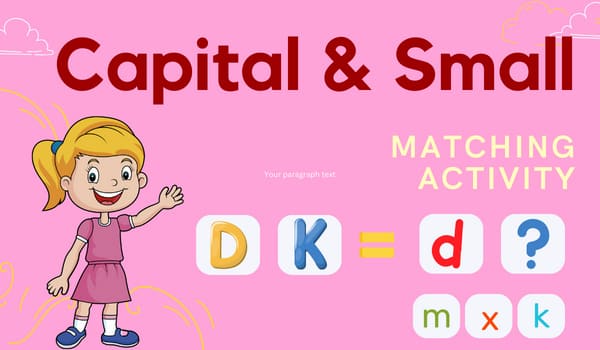What thoughts does your toddler have about letters? Can they distinguish specific letters? While studies suggest that toddlers need not know all letter names before engaging with books, understanding letters enhances their communication skills. Recognizing and quickly identifying crucial letters aids in associating sounds with the correct letters when decoding words.
Alphabet Letter Identification Assessment of Toddlers in Steps:
- Download the Alphabet Identification Assessment PDF file.
- Instruct your toddler to distinguish between uppercase and lowercase letters.
- Utilize the drag-and-match feature in the Alphabet Recognition App to assess your toddler’s letter identification skills. Pay attention to distinctions between small and capital letters for each alphabet.
- Encourage your toddler to name the letters as they match them, noting their accuracy.
- Repeat the assessment multiple times and record your toddler’s progress in recognizing the letters.
- Use a variety of methods such as flashcards, alphabet charts, and letter tracing activities to continue developing your toddler’s letter recognition skills.
- As your toddler gets better at recognizing letters, introduce them to letter-sound relationships and phonics.
- You can also create fun activities such as scavenger hunts or alphabet games to make the learning process more engaging for your toddler.
- Consistency is key in helping your toddler learn their letters. Make sure to set aside regular time for practicing and reviewing letter recognition.
- Celebrate each milestone and encourage your toddler to keep learning. With consistent practice, they will soon be able to identify all the letters of the alphabet with ease.

How to score based on the letter identification assessment application?
Place a checkmark in the section for each correct letter or sound identified by your toddler. Record any inaccurately named letters or sounds in the provided crates. Tally the correct checks for letters or sounds and sum them on the score sheet.
Score correctly for letter identification:
- A letter set name.
- Also, consider scoring a correct response when a child identifies both the letter and a word containing that letter (e.g., “There’s a ‘t’ in ‘cat.'”)
Score as right for sound ID:
- A sound that is adequate for the letter.
- A response in which the student says, “It starts like…” and provides a word with that letter sound as its initial letter.
Record for additional instructing:
- Your toddler’s favored method of recognizing letters (for example name, sound, or word that contains the letter).
- The letters a kid befuddles. It is suggested that one of the confounded letters is educated to the authority before presenting the other befuddled letter. In this manner, befuddled letters are kept separated in the education program.
- Unknown letters.
What do you notice: (Does not know names, yet perceives in words; knows names, however no letter/sound match; switched letters; straight-line known, bent obscure, and so on.)

